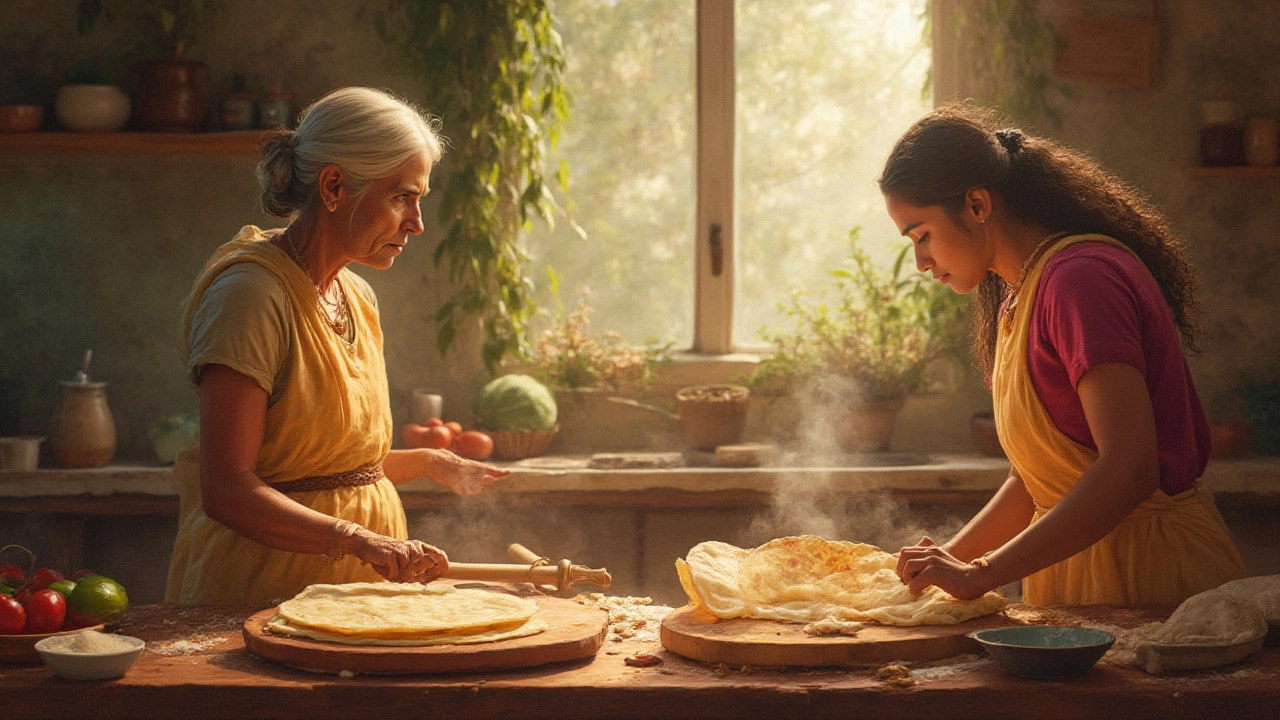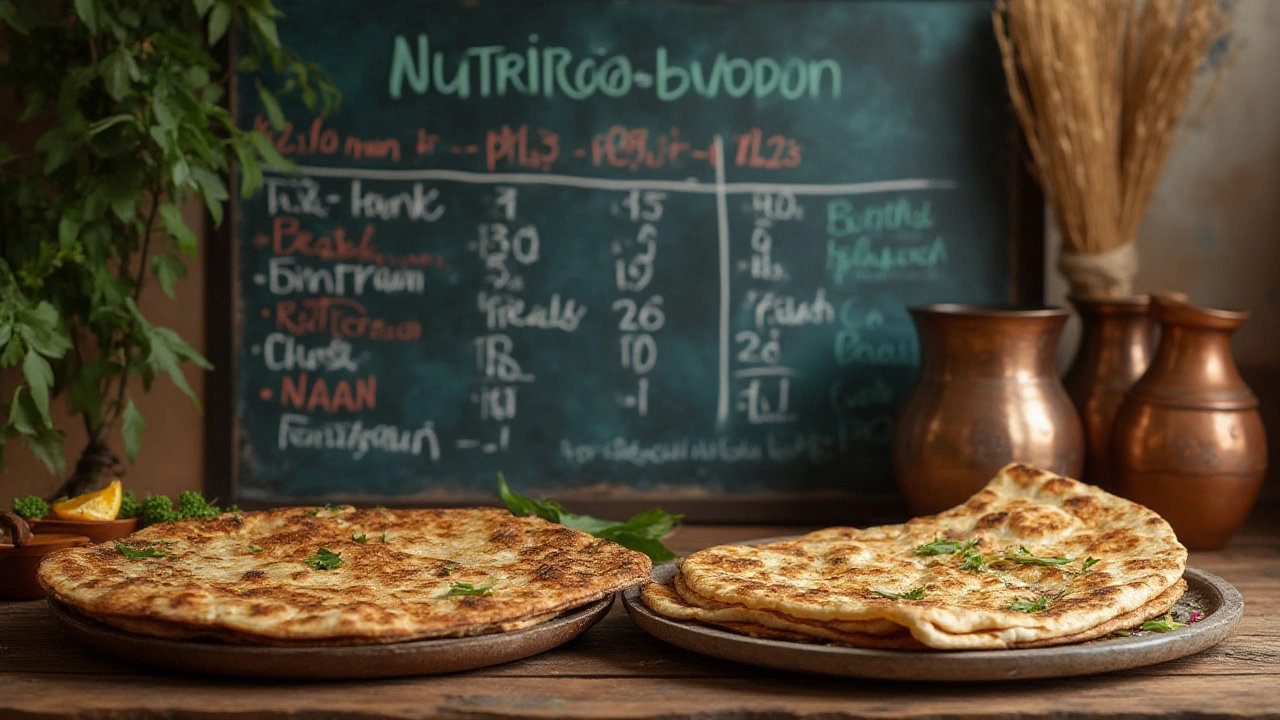Roti vs Naan: Which Indian Bread is Healthier for You?
 Jul, 5 2025
Jul, 5 2025
Picture this: you’re standing in your favorite Indian restaurant, the aromas making your stomach rumble, and you’ve got to choose between fresh roti or soft, buttery naan. They both sound tempting, but which one does your body thank you for later? It’s not just about taste or texture—there’s a world of difference between these two, and not in ways most people imagine. Folks in households across the globe eat both, often without a second thought. After chatting to some dietitians and also having lived in households where these breads were eaten daily, I found there’s more under the surface. Here’s what actually makes roti and naan different in terms of health.
What Exactly Are Roti and Naan?
You might think these breads are cousins, but they’re more like distant relatives with their own quirks. Roti is the everyday bread in most Indian homes. It’s made with wholemeal flour, water, and maybe a touch of salt—simple and stark, with no frills. It’s cooked dry on a skillet or open flame. Naan rolls in with a fancier vibe: it often uses refined white flour (maida), sometimes includes yogurt, milk, ghee, or even eggs. Traditionally it’s baked in a tandoor oven, puffing up to a golden, chewy finish. Naan is usually reserved for special occasions or to soak up those rich, saucy curries.
Now, here’s something surprising: roti from wholemeal flour is sometimes called chapati, and in some places, “naan” just means bread. But outside India, people almost always mean the thick, fluffy tandoor naan that can come topped with garlic or brushed in butter. The difference in texture comes down to the fat and dairy in naan and the absence of those extras in roti. So your starting point—wholewheat vs. white flour, plain vs. enriched—already tips the health scales.
Nutritional Breakdown: Calories, Carbs, and More
Looking at a side-by-side comparison, roti is sort of like the bread version of brown rice, while naan is its white, buttery counterpart. A plain roti (about 6-inch diameter) packs 70-90 calories, gives you 15-18 grams of carbs, 2-3 grams of protein, barely a gram of fat, and a bonus hit of dietary fiber from the wholewheat. Fiber helps your gut, manages blood sugar, and fills you up.
Flip to naan: a single piece sometimes tips the scales at 200-300 calories because of white flour, dairy, and sometimes butter or even sugar. Carbs surge up to 40 grams or more. Protein content’s roughly the same—from the flour and the yogurt or milk in some recipes—but fat can be over 6-10 grams per naan due to the ghee, milk, or oil. Fiber? That drops way down, since refined flour leaves most fiber behind in the factory making maida. So you get a softer bite, but you’re missing out on roughage.
Now, if you’re on a diabetic diet or watching your waistline, this makes a huge difference. Research published in the Indian Journal of Medical Research in 2022 found people eating wholewheat roti had lower blood sugar spikes than when eating naan. And the type of carbohydrate in wholewheat flour digests slower, saving you from sudden hunger pangs.
What Do These Differences Mean for Your Health?
The obvious call is calories and carbs—roti is lighter and has more fiber, so it’s calmer on your blood sugar and fills you up faster. Naan’s higher fat and calorie count means it can be risky if you’re eating several pieces with each meal. And it’s not just theory; hospitals in Mumbai swap out naan for roti for cardiac and diabetic patients—it’s less taxing for the system.
But don’t write off naan completely. It’s got its perks: yogurt and milk add some calcium and soft protein into the mix, which can be a small plus if you’re not getting much dairy elsewhere. And it’s true naan feels richer, creamier, and goes insanely well with butter chicken at your local Indian joint. Here’s a wild real-life trick—order your naan “without butter” at restaurants, or go for roti if they offer it. Place like Indian street food stalls in Parramatta or Harris Park, Sydney, often have both now to cater for different crowds who want to control their diet.
There’s also the point about sodium. Naan recipes sometimes have more salt, and if you’re eating out, they may add a sprinkle on top or in brushed butter. People on low-sodium diets should keep this in mind.

Whole Wheat or White Flour: Does It Matter?
Short answer: hugely. Whole wheat (atta) flour in roti brings vitamins, minerals, and antioxidants. You get iron, magnesium, zinc, and a good shot of B vitamins. White flour (maida) has most of that stripped out—even the “enriched” versions bring back only a little. Research from the CSIRO in 2023 showed Aussies eating more wholegrains had better gut health, lower risk of heart disease, and steadier energy levels.
Some restaurants now offer “whole wheat naan” as a compromise—it’s chewier, nuttier, and has a bit of fiber back in the game. Nothing beats homemade, though. Skipping ghee or butter, and using yogurt instead of cream cuts fat and calorie levels too. If you’ve got time, making your own roti is easier than you think (just flour, water, and a pinch of salt). And you can roll out a stack for the week and freeze extras for busy days.
If gluten bothers you, both breads have it—though roti with 100% atta might be easier for some. There are gluten-free “rotis” made from millet or sorghum, which are getting popular in specialty stores in Sydney.
Tips for Making Your Bread Healthier
If you miss naan’s pillowy softness but want to eat healthy, try these tips:
- Ask for whole wheat versions when eating out (especially in bigger cities—they’re catching on).
- Go easy on butter, ghee, or oil. Most of the time, breads don’t need it to taste great if you’ve got a flavourful curry.
- Try baking or making roti with added seeds—ground flaxseed or chia can bump up healthy fats and fiber.
- Cut down portion size. Share naan, or order a half and add some salad or veggies to fill up.
- Try “Missi roti” sometimes: it’s made with chickpea flour mixed in, for more protein and extra flavour.
And here’s a cool one: you can make your own naan at home on a frying pan—skip the tandoor, skip the butter, and use Greek yogurt for a lighter version.
So, Which One Should You Choose?
If you’re after the healthiest pick, roti wins by offering more fiber, less fat, and steady carbs. That said, there’s nothing wrong with naan now and then, especially for special meals out or when nothing else will do. Real balance comes from how the bread fits with your overall meal. If you’re eating with loads of heavy, creamy curries, skipping rich breads certainly helps. If you’re cooking dal or grilled chicken, a warm roti makes a great combo without weighing you down.
At the end of the day, listen to your body. If you’re full with one roti, don’t feel pressured to keep up with the table. If you crave naan, go for it, but maybe with a healthier main dish. Health isn’t about all-or-nothing. I’ve seen families in Sydney prep roti from scratch Saturday mornings, while saving naan for a Friday dinner out. That balance keeps both your taste buds and your health happy.
In short—roti’s your go-to for health, naan’s your treat for those “I’ve earned this” moments. Whichever you pick, enjoy every bite—because food, at its heart, should make life a little fuller.
